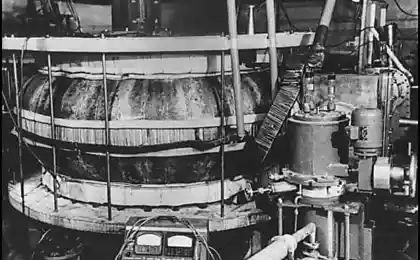484
Alternative power stations as the solution to the issue of energy independence
In several countries at the same time begin to implement projects relating to the use of possible alternative sources of energy from ocean waves and tides. Similar projects are treated in Germany, Australia, Britain, Canada and the United States. In the journal Nature provides a complete overview of these technologies, an example of their installations and the feasibility.

From the oceans, tides and waves can extract energy minimum. Soon these countries will launch several similar projects of such stations, which can use the power of the ocean as an alternative source of energy.
A similar installation is going to run in Australia and in the Indian ocean, just a few hundred kilometers from the coast of Perth. Here we will use all of the mechanical energy of the waves.
And if the energy of the waves is just beginning to be actively used, solar energy is collected with special devices for a long time. The solar panel is able to provide energy to the whole cottage, including their use for water heating.
So, a shower stall can be used by all members of an average family during the day, and the heated water is accumulated in special containers, will be enough.
As for ocean waves, at the surface of the water will be orange floats, which will fluctuate in waves, forcing you to run hydraulic pumps. To them attach long cables that will be installed at the bottom of the ocean. Such a power plant can produce more than 750 kilowatts of electricity, that's enough to provide located near the naval base.

In the UK, closer to the South-East of Belfast are already using tidal energy. About twice a day, more than 360 million cubic meters of sea water passes through two huge 16-metre rotor.
Due to their spins, they are able to produce about 1.3 megawatts of electricity. This figure is equivalent to a wind that blows at speeds of over 600 kilometers per hour, rotating wind propellers per minute to 20 revolutions.
In Edinburgh, UK, using the energy of the waves provide another original project. Sea surface buoys floating five, between them there are hydraulic pumps, the pumped liquid is forced to work the generator.
Unfortunately, at present the work and design of alternative energy sources is directly related to very low economic efficiency. After construction of the stations require investments that take a long time to pay off. In addition, there are specific difficulties associated with the interruption of electric power generation from such plants.
There are new environmental issues that affect the annoying noise from the blades of the propellers, and the possible effects of electromagnetic fields obtained from transformers of power plants.
Source: zeleneet.com

From the oceans, tides and waves can extract energy minimum. Soon these countries will launch several similar projects of such stations, which can use the power of the ocean as an alternative source of energy.
A similar installation is going to run in Australia and in the Indian ocean, just a few hundred kilometers from the coast of Perth. Here we will use all of the mechanical energy of the waves.
And if the energy of the waves is just beginning to be actively used, solar energy is collected with special devices for a long time. The solar panel is able to provide energy to the whole cottage, including their use for water heating.
So, a shower stall can be used by all members of an average family during the day, and the heated water is accumulated in special containers, will be enough.
As for ocean waves, at the surface of the water will be orange floats, which will fluctuate in waves, forcing you to run hydraulic pumps. To them attach long cables that will be installed at the bottom of the ocean. Such a power plant can produce more than 750 kilowatts of electricity, that's enough to provide located near the naval base.

In the UK, closer to the South-East of Belfast are already using tidal energy. About twice a day, more than 360 million cubic meters of sea water passes through two huge 16-metre rotor.
Due to their spins, they are able to produce about 1.3 megawatts of electricity. This figure is equivalent to a wind that blows at speeds of over 600 kilometers per hour, rotating wind propellers per minute to 20 revolutions.
In Edinburgh, UK, using the energy of the waves provide another original project. Sea surface buoys floating five, between them there are hydraulic pumps, the pumped liquid is forced to work the generator.
Unfortunately, at present the work and design of alternative energy sources is directly related to very low economic efficiency. After construction of the stations require investments that take a long time to pay off. In addition, there are specific difficulties associated with the interruption of electric power generation from such plants.
There are new environmental issues that affect the annoying noise from the blades of the propellers, and the possible effects of electromagnetic fields obtained from transformers of power plants.
Source: zeleneet.com























